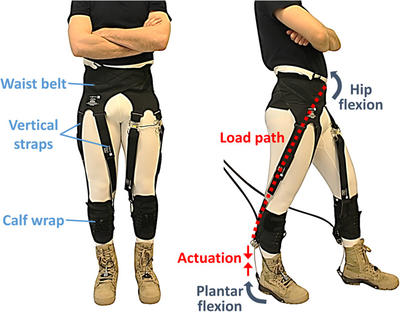Walking. For many, it is something that is done without much thought at all.
But whether through disability, accident, or age, sometimes walking can be a real challenge. It can also be difficult when a person needs to carry heavy things over long distances.
This is a problem that researchers at the Harvard Biodesign Lab are looking to solve with a new innovation. It is a soft robot suit—or exosuit—that is worn over the legs. It uses sensors to observe how a person is walking—how fast, over what terrain (surfaces or angles), and whether they are struggling. Then, it sends out impulses to give a person's leg muscles an extra boost where and when they need it.
Fascinating!
Feeling the rhythm
Sounds complicated! Which it is. But we're going to do our best to break in down because it's a very cool idea! Let's start by looking at how humans walk, and why it generally works so well.
Walking is what is known as a passive-dynamic process. It works without us needing to put a lot of thought or energy into it.
That's why humans can generally walk for a long time without getting too tired. Our legs' movement is like a swinging swing set. As the legs sway, they work with gravity to create momentum. All our muscles need to do is inject tiny bursts of power to help that swinging along, and presto—we're walking!
If you watch this video from the Harvard Lab between 1:00–1:14, you can see what we mean. They even highlight the muscles in the leg as they each provide those bursts of energy at the right moment so we can walk.
Under strain
Where walking becomes a struggle is when our muscles can't provide energy to keep that movement happening.
Sometimes this is because the muscles have grown weaker due to age. Sometimes it is because a physical or neurological disability is stopping the muscles from responding and providing the energy. And in other cases, the person walking is either carrying a heavy load or is walking up a steep hill or bumpy ground and not able to provide energy.
In all of these cases, the walking isn't so passive anymore. Those muscles need a boost!
Reading and responding

A diagram that shows how the device fits on a person. Doesn't look like a robot, does it? (Harvard Biodesign Lab)
This is where that robot suit comes in.
It has a series of sensors all across the legs—the hips, thighs, knees, calves, and ankles—that are designed to read how things are going as the person is moving. This way, the robot can read in real time (or as it is happening) where the problems are.
Then, it springs into action! Devices called actuators send tiny electric impulses—bursts of energy—to certain muscles. These impulses help to urge the muscles along in a way that is very similar to how our bodies work naturally.
Future of movement?
The suit is still in the prototype stage. But the researchers hope that eventually these soft robots can replace things like metal leg braces, or canes and walkers. Because the suit is made of fabric, it can be as form-fitting and comfortable as a pair of leggings and could be worn under pants, even.
Sounds like an incredible innovation to us!
 Currently, metal devices like walkers are used to assist those who struggle with walking. (ID 99367142 © Katarzyna Bialasiewicz | Dreamstime.com)
Currently, metal devices like walkers are used to assist those who struggle with walking. (ID 99367142 © Katarzyna Bialasiewicz | Dreamstime.com)










: 😯 thats really cool i luv how it can help so many people